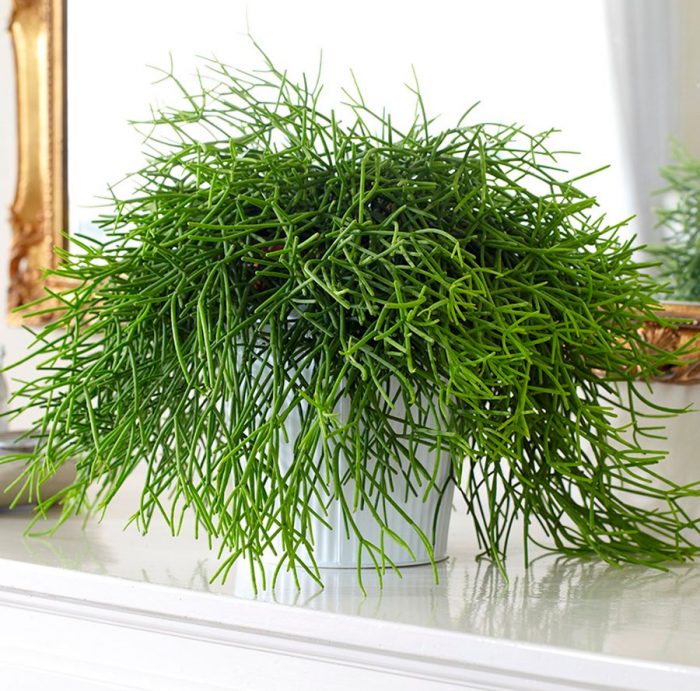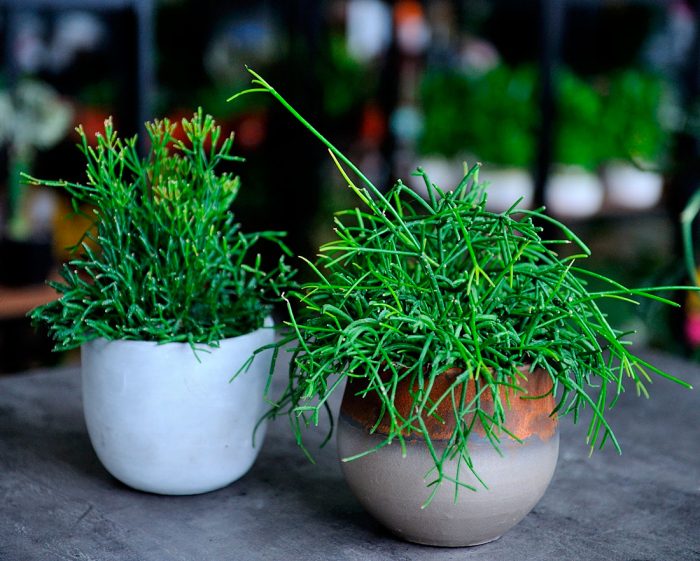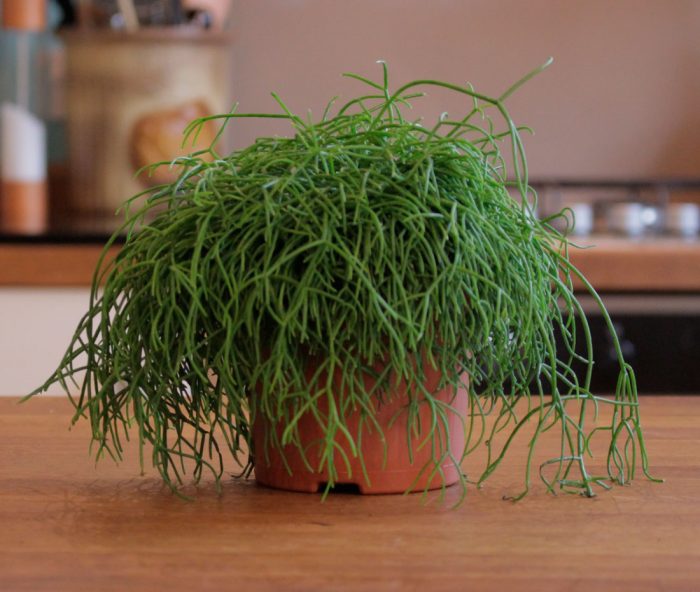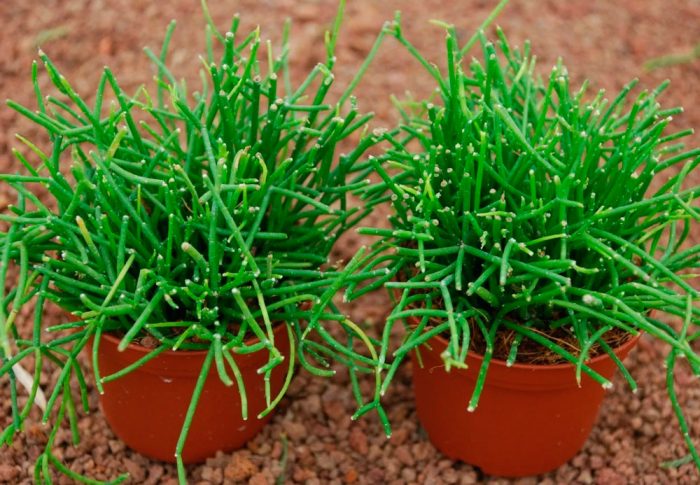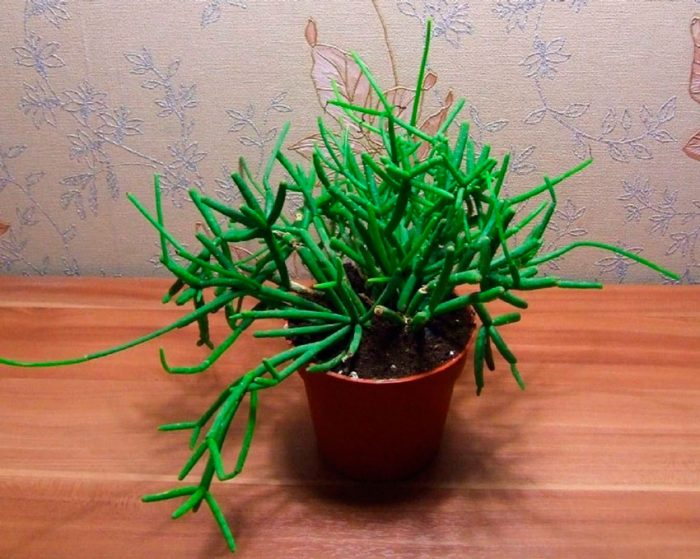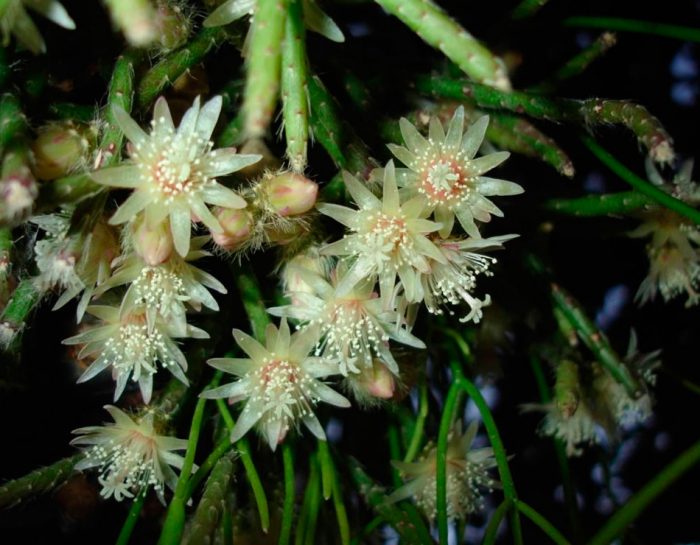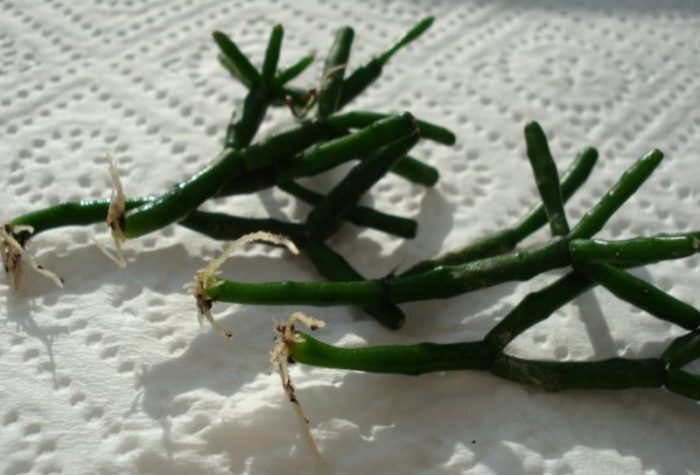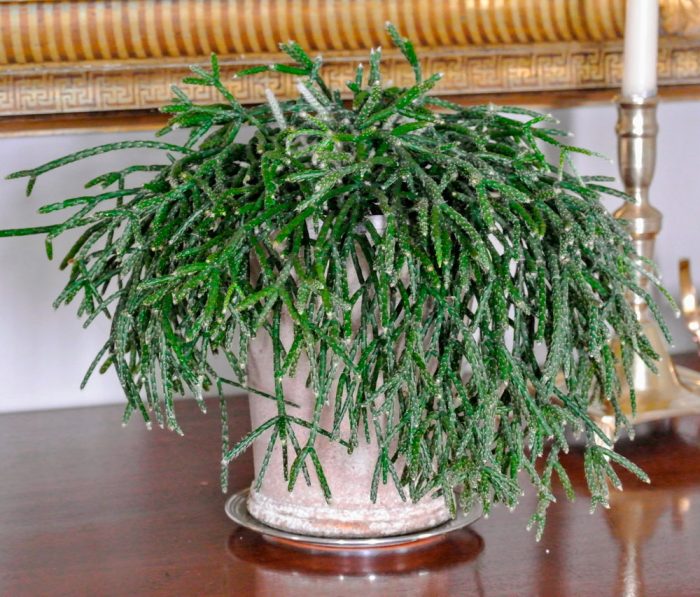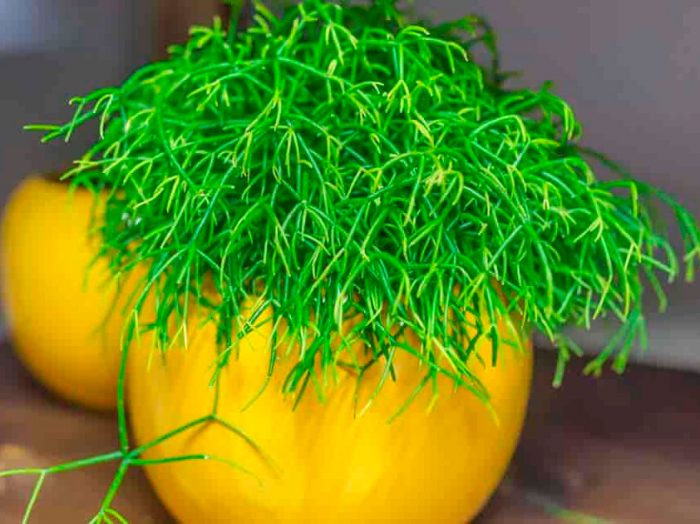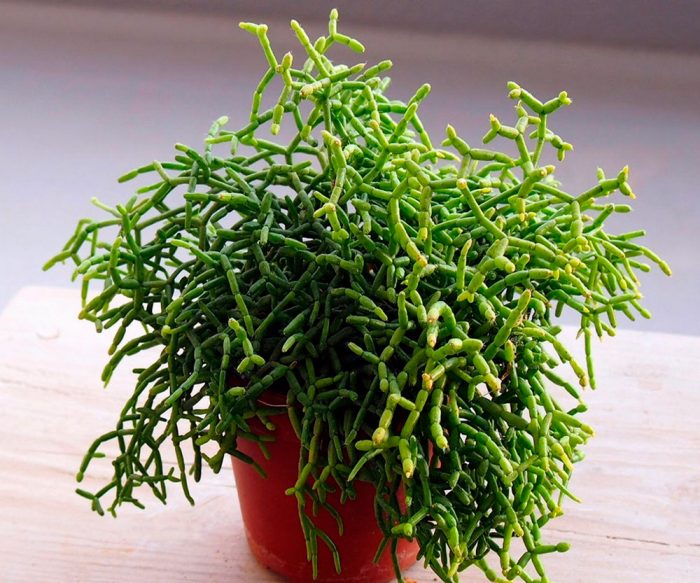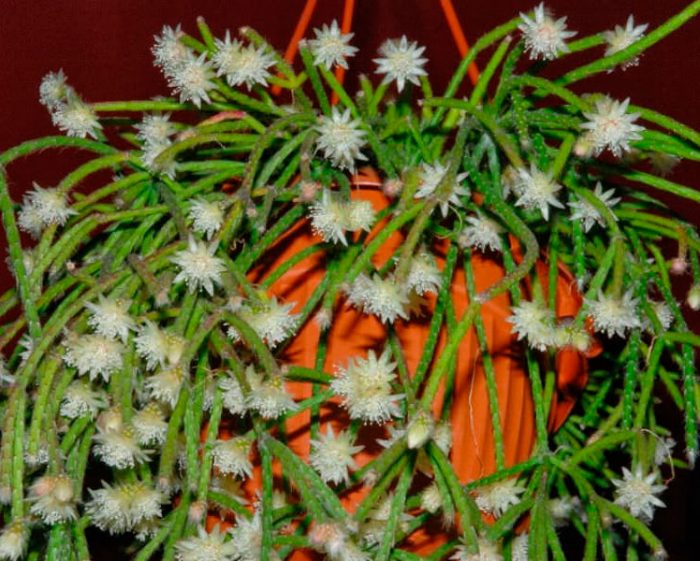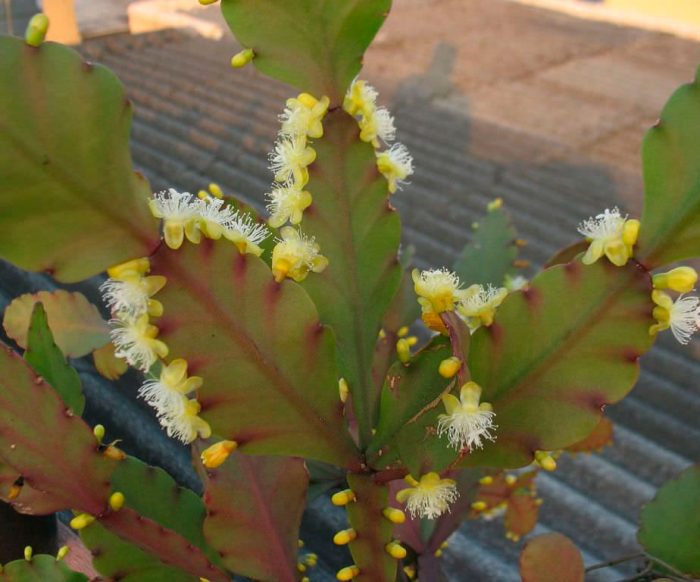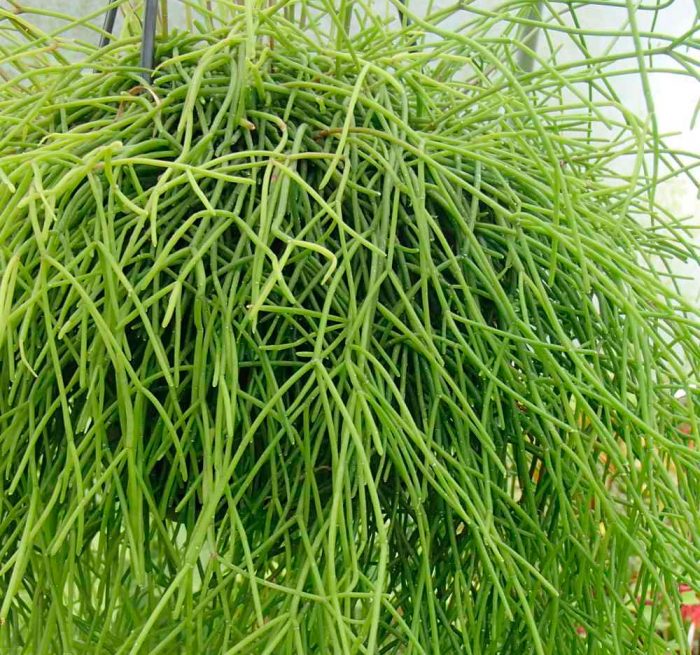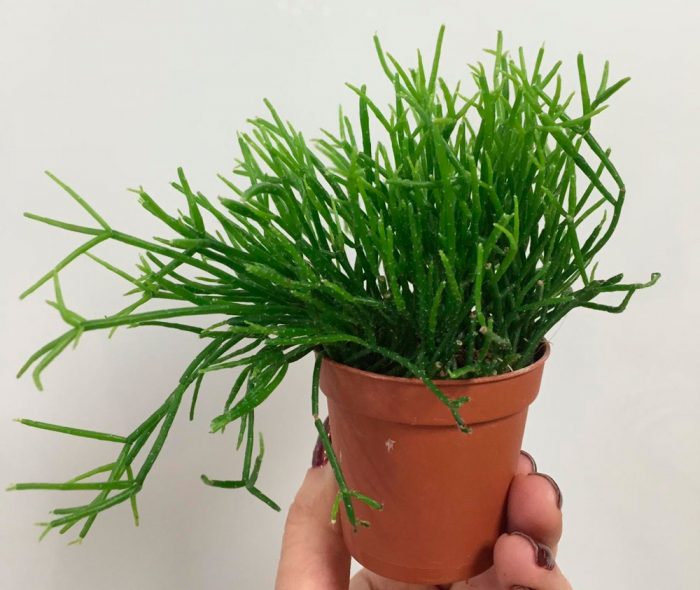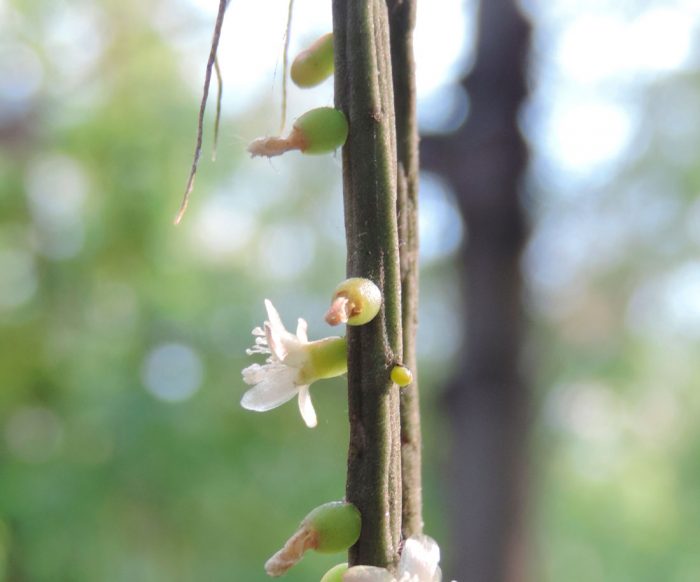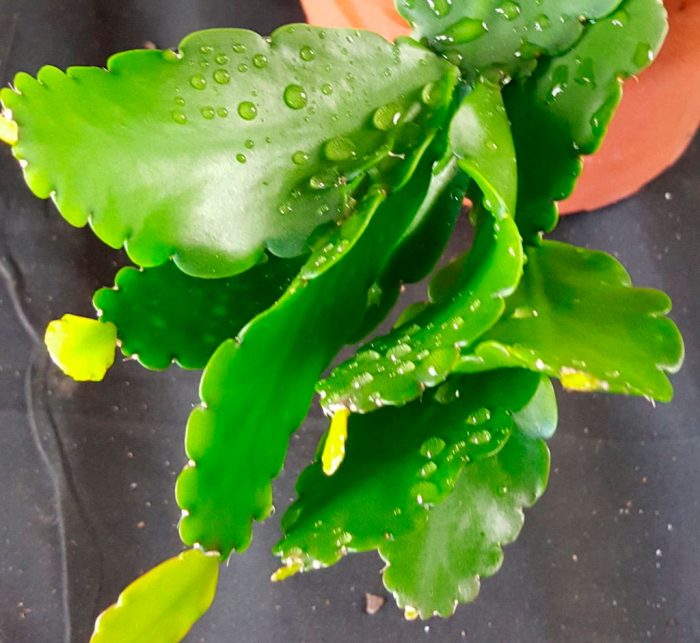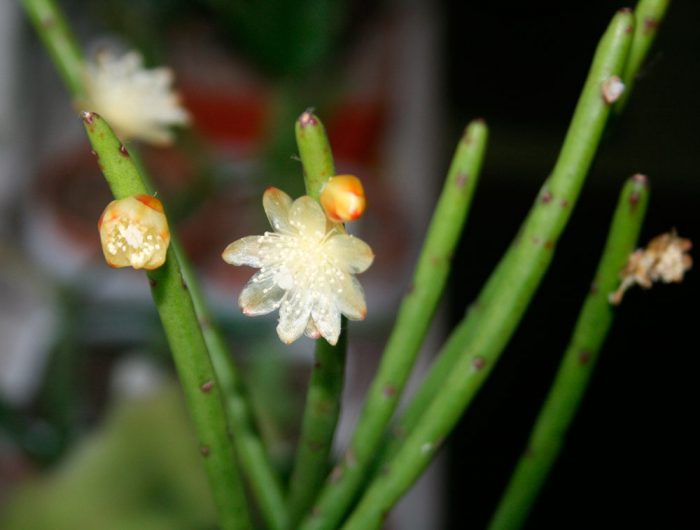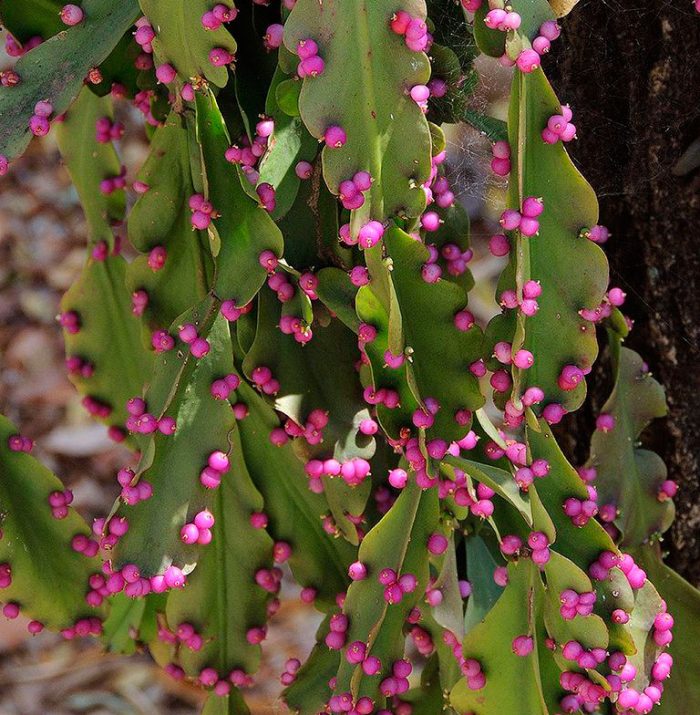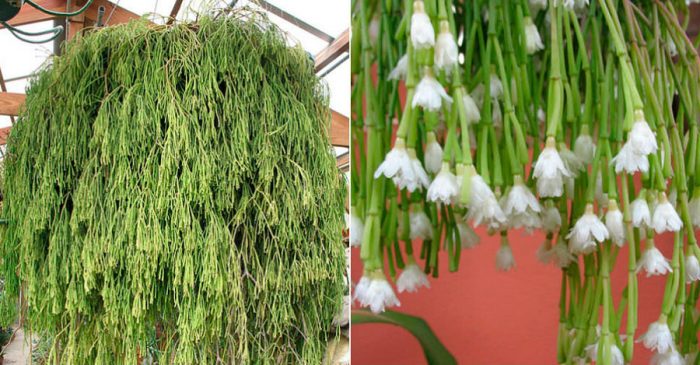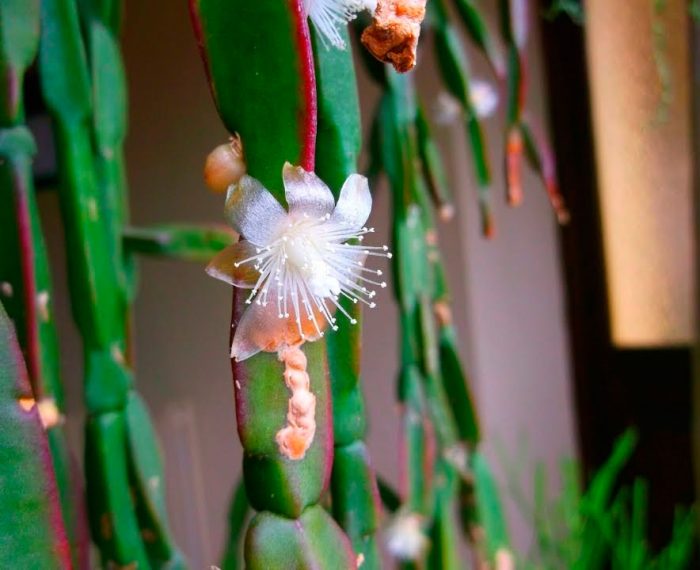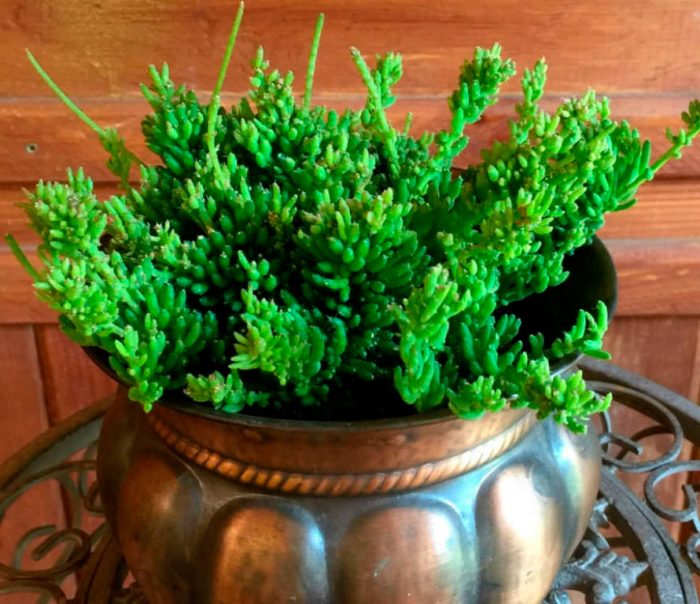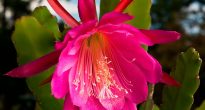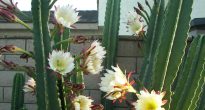The plant Rhipsalis (Rhipsalis), also referred to by some growers as rods, belongs to the Cactus family. This genus is represented by shrubs, while it unites more than 50 different species. Under natural conditions, such an epiphytic plant can be found in tropical rainforests located in Africa, South Asia, and North and South America, and they prefer to grow on damp rocks, tree trunks, and sometimes on the ground. Only this cactus has an area beyond America. Some of the ripsalis species have long been and very successfully cultivated at home.
Content
- 1 Brief description of cultivation
- 2 Ripsalis features
- 3 Ripsalis care at home
- 4 Reproduction methods
- 5 Diseases and pests
- 6 Types and varieties of ripsalis with photos and names
- 6.1 Rhipsalis cereuscula
- 6.2 Rhipsalis pilocarpa
- 6.3 Rhipsalis pachyptera
- 6.4 Rhipsalis hairy (Rhipsalis capilliformis)
- 6.5 Rhipsalis cassutha
- 6.6 Rhipsalis Barchela (Rhipsalis burchellii)
- 6.7 Rhipsalis lindbergiana
- 6.8 Curly Rhipsalis (Rhipsalis crispata)
- 6.9 Elliptic Rhipsalis (Rhipsalis elliptica)
- 6.10 Rhipsalis fluffy (Rhipsalis floccosa)
- 6.11 Rhipsalis oblonga
- 6.12 Rhipsalis russellii
- 6.13 Rhipsalis clavata (Rhipsalis clavata)
- 6.14 Rhipsalis strange (Rhipsalis paradoxa)
- 6.15 Rhipsalis mesembryanthemoides
- 6.16 Rhipsalis teres
Brief description of cultivation
- Bloom... As a rule, in the last winter or first spring weeks. If the ripsalis is provided with good and proper care, then its flowers will decorate several times a year.
- Illumination... It can grow both in light shade and in bright, diffused light. It is recommended to put the bush on the east or west window, and in the afternoon it must be protected from direct sunlight.
- Temperature regime... In the warm season - from 18 to 24 degrees, and in winter - from 15 to 17 degrees. In the room where the flower is located, the temperature should not drop below 10 degrees.
- Watering... The substrate is moistened systematically and only after it is 1/3 dry.
- Air humidity... It needs high air humidity, so it is recommended to use a household humidifier. You can also increase the humidity of the air by pouring wet pebbles into the pallet and placing a container with a flower on it.
- Fertilizer... Top dressing is carried out from March to October 2 times a month, for this they use a complex mineral fertilizer for succulents and cacti. You can also use other complex fertilizers, but you need to take them in half the dose recommended by the manufacturer (see the package). The cactus does not need feeding from October to March.
- Dormant period... In winter or after flowering for 4-6 weeks.
- Transfer... While young bushes are subjected to frequent transplantation, which is carried out once a year, while adult specimens are transplanted 1 time in 4 or 5 years. The transplant is carried out by the transshipment method.
- Reproduction... By dividing the bush, cuttings and seed method.
- Harmful insects... Red flat spider mite and scale insect.
- Diseases... Chlorosis.
Ripsalis features
Rhipsalis is an epiphytic shrub with strong branching and aerial roots. All representatives of this genus have pubescence on the surface of the aboveground parts, and none of the species have spines. Leafy drooping, articulated shoots in cross section can be rounded, ribbed or flat. Areoles are placed on the surface of the shoots. Actinomorphic small flowers have a corolla that can be yellow, pinkish, white and orange. Flowers are placed either at the top of the stem or along its entire length. Ripsalis produces berry-like juicy fruits the size of a gooseberry, and they can be colored black, white or pink.
Ripsalis care at home
Ripsalis cactus, when grown at home, is distinguished by its unpretentiousness. But in order for the plant to grow and develop within the normal range, it should provide conditions as close as possible to natural ones, namely: the temperature and illumination should be optimal, and one should also not forget about timely watering and feeding.
Temperature regime
In the warm season, the cactus grows best at an air temperature of 18 to 24 degrees. In the winter months, the flower rests and gains strength, and at this time it needs coolness (from 15 to 17 degrees). It is able to withstand a short-term temperature drop of up to 10 degrees. However, Ripsalis should not be allowed to stay in a room for a long time at 10 degrees Celsius. If you cannot move the bush to a cool place for the winter, then it will stand quite normally all winter and at normal room temperature.
Illumination
This cactus naturally grows in the shade of a rainforest, and therefore direct sunlight can greatly harm it. Therefore, it is highly undesirable to choose a southern window for it. Best of all, it will grow on a windowsill with a western or eastern orientation, but do not forget to protect the bush from direct scorching sunlight in the afternoon. If desired, the plant can be placed in the back of the room or on the north window, however, its growth and development in this case will be slower, and the bush may not bloom at all.
Watering
The soil mixture in the pot is moistened only after it dries out to a depth of 1/3 part. To understand whether it's time to water the cactus or not, take a long wooden stick and stick it into the substrate (you need to get it to the very bottom of the flower pot). Remove the stick and use the sticky soil mixture to determine its moisture level. With a cool winter, the number of watering must be reduced, however, if the plant is at room temperature in winter, then the substrate must be moistened in the same way as in the warm season, especially if the air in the room is greatly dried up by working heating devices. In winter, it is also necessary to moisten the soil mixture only after it dries out to a third depth.
Ripsalis can be watered only with well-settled water for two days or with water passed through a filter, the temperature of which should be close to room temperature. When moistening the substrate, remember that watering should not be either too scarce or too abundant, since in either case it will have an extremely negative effect on the health of the cactus.
Air humidity
In nature, ripsalis grows in conditions of high humidity. That is why, at home, he needs high humidity.And to increase the level of humidity, you can use a regular household humidifier. If you can't afford a humidifier, then regularly humidify the air in the room from a spray bottle several times a week, and you can also put the pot with cactus on a wide tray filled with wet expanded clay or pebbles. It is also very useful for the plant to sometimes arrange a warm shower, which will remove dust from it, and this procedure will also refresh the bush.
Top dressing
In March – October, Ripsalis has a growing season, and therefore it is at this time that it needs additional nutrients. Top dressing is carried out regularly 2 times a month, for this they use a mineral complex fertilizer for succulents and cacti in liquid form. Instead of such fertilizer, you can use conventional mineral complexes intended for indoor flowers, but in this case, the dosage recommended by the manufacturer is halved. When feeding Ripsalis, remember that there should not be too much nitrogen in the substrate, as this can have an extremely negative effect on its health. During the dormant period, which lasts from October to March, the bush is not fed, but only if it is in a cool place (from 15 to 17 degrees). During warm wintering, fertilizers should be applied to the substrate regularly and at the same dosage.
Ripsalis transplant
While the ripsalis is young, it needs annual transplants, the grown plant is subjected to this procedure once every 3 years, and the adult is transplanted even less often - only once every 4 or 5 years. The fragile root system of such a plant is very close to the surface of the substrate, because of this, wide, but low flower pots are chosen for its transplant. You need to transplant the bush very carefully, using the transshipment method for this, and try to keep the earthen ball on the root system intact.
First, make a drainage layer of expanded clay at the bottom of the pot, the thickness of which should be equal to ¼ of the height of the container. Thanks to this drainage, there will be no stagnation of water in the roots of the cactus. Then transfer the plant from the old pot to the new one, and fill all the voids with a special soil mixture, which should be slightly acidic or neutral. To prepare it, combine peat, river sand, turf and leafy soil (all components are taken in equal parts). Also, a substrate consisting of sand, leafy and soddy soil (1: 2: 4) is suitable for transplanting. To disinfect the substrate and prevent the appearance of rot on the roots, a small amount of charcoal is poured into the substrate.
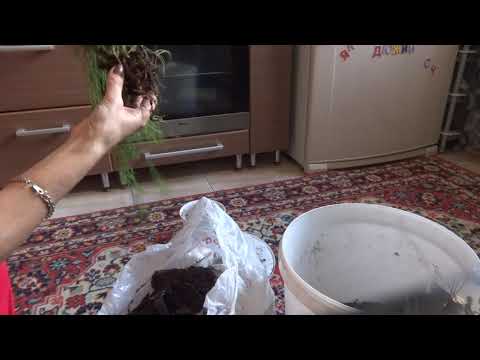

Watch this video on YouTube
Bloom
Most often, indoor Ripsalis blooms in the last winter or first spring weeks. However, it also happens that the cactus does not bloom at all, and this is very perplexing for the grower. In this case, experts advise paying attention to the conditions under which the cactus is grown, namely: whether it has enough light and nutrients, and whether you water it correctly. There is also such that the bush throws off already formed buds. This can happen if rot appears on the root system, a clod of earth in a pot is completely dry, or the plant has been moved to another place.
Reproduction methods
Propagation by cuttings
Rhipsalis can be propagated very easily by cuttings. To do this, break off a part of an adult (not old and not too young) stem and leave it outdoors for a while to dry. To root such cuttings, flower growers do not use water, they are immediately planted in a moistened mixture consisting of one part of peat and the same amount of river sand. Cuttings take root most quickly when warm (23 to 25 degrees).To create a greenhouse effect, it is recommended to cover the container on top with a transparent cap, but do not forget to ventilate the cuttings every day, as well as remove condensate from the shelter in a timely manner.
Dividing the bush
You can propagate the plant by dividing the bush during transplantation. However, it is necessary to divide the cactus very carefully, since its root system is very fragile. Delenki are planted in pots prepared in advance, at the bottom of which a drainage layer is made in advance, the soil mixture is used the same as for transplanting (see above). Transplanted delenki must be watered well. At first, the bushes should be shaded from direct sunlight.
Growing from seeds
The generative method of reproduction of such a plant is not very popular among flower growers. However, if desired, ripsalis can still be grown from seeds. To do this, they are sown in a small container filled with a suitable substrate, and watered regularly so that the soil mixture is slightly damp all the time. Seedlings appear together. Fortified and grown plants are subjected to a pick, after which they are kept warm (from 23 to 25 degrees).
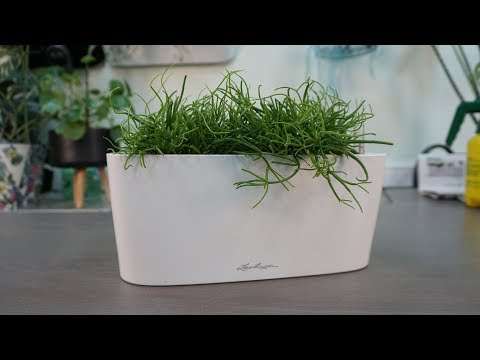

Watch this video on YouTube
Diseases and pests
Diseases
Chlorosis can cause great harm to ripsalis. Because of it, there is a shrinking and yellowing of the foliage, as well as its premature flying around, and its veins remain green. The buds and flowers are deformed. The root system is also affected by the disease, and this can lead to its death. In order to prevent chlorosis, Ripsalis is recommended to provide the required amount of light, and for planting or transplanting, a soil mixture of suitable acidity (pH 5.0-5.5) should be chosen. In some cases, the disease begins to develop from tap water, as its pH can go up to 7.0. In this case, experts advise to systematically spill the substrate in a container with water, with a small amount of citric acid dissolved in it. This water should taste only slightly sour. In addition, the flower is systematically fed with iron in a chelated form, because such an element is absorbed most quickly by it. It should be remembered that such a nutrient solution is used for foliar foliar feeding.
Harmful insects
For such a plant, of the pests, the most dangerous are red flat spider mites and scale insects. If scale insects have settled on the bush, then first you need to remove adults from the cactus, using a cotton swab for this, which is moistened in a soap solution or in alcohol. This is due to the fact that adult scale insects are covered with a strong shell, which protects both them and the eggs laid by them from any poisons. Rinse the cactus thoroughly under a warm shower and let it dry completely. Then it is necessarily sprayed with a solution of a suitable insecticidal preparation, for example: Aktara, Aktellika, Fitoverma, etc. If there are a lot of pests, then it will not be possible to get rid of them at once, so be prepared for a long fight with them and for several treatments.
On ripsalis, spider mites settle only if the air in the room is very dry. However, such a plant requires constant high humidity, so if you provide it with proper care, then there should be no problems with mites. But if, nevertheless, pests were found on a cactus, then try to make sure that there is always high humidity near the plant. First, give the bush a warm shower, and then humidify the air around it every day. In conditions of high humidity, mites will not be able to exist. However, if there are a lot of pests on the bush, then it will not be so easy to get rid of them.In this case, a shower is arranged for the flower, and then it is sprayed with a solution of any acaricidal preparation, the most effective of which are such as: Aktellik, Aktara, Sunmayt, Apollo and Kleschevit.
Types and varieties of ripsalis with photos and names
Rhipsalis cereuscula
Or cereus-shaped ripsalis, or candle-shaped ripsalis. This type is most popular with flower growers. Three-dimensional lush lace is formed from short and thin shoots of the second order growing in different directions. The long main stems are arched. During flowering, white flowers appear on the bush, reaching about 20 mm in diameter. But this species blooms extremely rarely in indoor conditions, and flowering is poor even if the most favorable conditions for growth have been created for the ripsalis.
Rhipsalis pilocarpa
Unlike the species described above, this plant has more powerful and tough stems that do not branch very much. Their surface is covered with pubescence, which consists of pale yellow hairs. If such Ripsalis is grown in optimal conditions for it, then it can bloom up to three times during the year. The fragrant whitish-yellow flowers look fluffy due to their many stamens and petals. The flowers themselves reach up to 2.5 cm in diameter.If these flowers are pollinated, then very soon the fruits of a spherical shape and rich crimson color will form on the bush. Such fruits look just as impressive as flowers.
Rhipsalis pachyptera
Or thick-winged Ripsalis, the most popular member of the Ripsalis group with leafy shoots. Such a plant has very large shoots, in some cases their width may be equal to the width of the palm. The shoots are glossy with a scalloped edge, and they are painted in dark green with a red tint. Pale yellow flowers bloom along the edge of the leaf plates, reaching about 15 mm in diameter, they are decorated with many stamens.
Rhipsalis hairy (Rhipsalis capilliformis)
This ampelous epiphytic plant has soft, thin branching shoots, painted in a greenish tint, which form a dense flowing bush. Shoots can reach a length of about 1.2 m.Sometimes this species blooms and then many small whitish flowers appear on it. Such a plant is especially impressive in adulthood.
Rhipsalis cassutha
Or empty ripsalis. In this species, the length of thin drooping shoots can reach up to three meters. They include many segments, and the length of each of them can be equal to 3–55 centimeters. During flowering, small flowers are formed, and the fruits of this type, after ripening, are similar to gooseberry berries.
Rhipsalis Barchela (Rhipsalis burchellii)
This epiphytic succulent plant is also grown indoors. Its primary stems reach up to 0.6 m in length. And the length of terminal shoots is about 60 mm, and in diameter they reach no more than 2 mm.
Rhipsalis lindbergiana
In this species, the primary stems reach about 100 cm in length, and up to 0.5 cm in diameter. Its secondary segments are not so long. Small flowers are colored light pink.
Curly Rhipsalis (Rhipsalis crispata)
The lush bush of this succulent consists of hanging stems. And these stems include flat segments of an elongated shape, each of which is decorated with a small cream-colored flower. When there are no flowers on the bush, it looks very much like a Schlumberger.
Elliptic Rhipsalis (Rhipsalis elliptica)
The elongated stems of such a plant include long sections. The total length of each shoot is about 150 cm, and each segment can be up to 10 centimeters long. Each of the segments has small flowers on the lateral edges, on the surface of which there is pubescence.
Rhipsalis fluffy (Rhipsalis floccosa)
This species is relatively large, its long stems, round in cross-section, lignify over time. During flowering, small white flowers are formed along the entire length of the stem. If pollination occurs, then white spherical fruits are formed on the bush.
Rhipsalis oblonga
The stems of this ampelous species consist of large segments, which are similar in shape to oak foliage.
Rhipsalis russellii
In such a plant, very effective fruits of a deep pink color are formed along the entire length of the stems.
Rhipsalis clavata (Rhipsalis clavata)
In this species, rod-shaped shoots are very branching, they are round in cross-section, and they include many short segments. During flowering, the bush is decorated with large white flowers, which are formed only on the tops of the shoots.
Rhipsalis strange (Rhipsalis paradoxa)
Or the ripsalis of the paradox. This species fell in love with flower growers for its unusual and very spectacular appearance. The fact is that its high ribs consist of segments alternating with flat intervals.
Rhipsalis mesembryanthemoides
This look is one of the most spectacular. Its main stems are covered with short shoots of the second order, which sit on them very tightly, just like needles sit on the branches of a spruce. In the winter months, during flowering between the shoots of the second order, snow-white flowers are formed, which have a star-shaped shape and reach up to 15 millimeters in diameter.
Rhipsalis teres
In this species, hanging stems reach about 50 centimeters in length, and their diameter does not exceed 0.5 centimeters, in cross section they are cylindrical. On their tops, 5–12 short segments are formed, which grow whorled. Small flowers of a whitish-yellow hue, reaching about 10 millimeters in diameter, adorn the bush during the flowering period.
Ripsalis ramulose is still very popular in culture. However, this plant is a pseudo-ripsalis, many more know it under the name "red mistletoe cactus". The fact is that this species is part of a completely different genus, although it belongs to the same family as the Ripsalis.
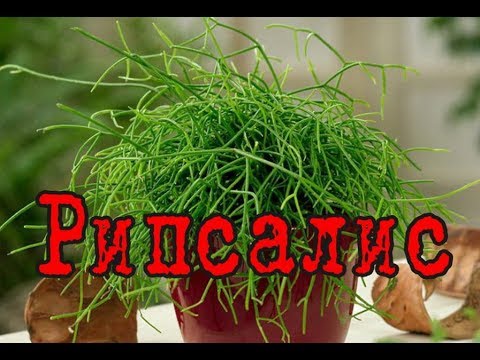

Watch this video on YouTube

